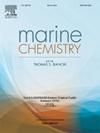进入北极中部的弗拉姆海峡的硼盐比值:海冰形成的作用和未来预测
IF 3
3区 地球科学
Q2 CHEMISTRY, MULTIDISCIPLINARY
引用次数: 0
摘要
北冰洋海冰的消失对碳吸收潜力产生了动态影响,这可以通过测量碳酸盐参数(如总碱度)来评估。在开阔的海洋中,硼(B)是通过硼酸盐造成碱度的第三大因素,通常通过保守的硼盐比值(B/S)来计算,而不是直接测量。在此,我们介绍了在进入北极中部的弗拉姆海峡的冰融化区水域、雪、泥泞、盐水和年度海冰(n = 169)中观察到的非保守硼动态研究结果,这种非保守硼动态会导致显著的 B/S 偏差。这些样本是在 2023 年 ARTofMELT 探险队的融化季节开始时采集的,覆盖了很宽的实际盐度范围(2-59)。除积雪外,整个研究的平均 B/S 比值为 0.1321 ± 0.0032 mg kg-1 ‰-1,与冰岛附近几个极地水团中测得的平均 B/S 比值以及其他海洋区域公认的 B/S 比值相似。结果表明,在整个样本实际盐度范围内,B/S 比值与公认的 B/S 比值有轻微偏差(表明行为保守),并反映出在原位温度下,硼酸盐对总碱度的贡献的不确定性小于 2.9 μmol kg-1。硼分馏似乎发生在海冰形成过程中,导致海冰储层中的硼含量增加,而盐水、泥浆、铅和冰下水储层中的硼含量减少。分别为 0.1305 ± 0.0011、0.1305 ± 0.0018 和 0.1304 ± 0.0017 毫克/千克-1 ‰-1)低于既定比率,而平均海冰 B/S 比率(0.1331 ± 0.0035 毫克/千克-1 ‰-1)最接近公认值(0.1336 ± 0.0005 毫克/千克-1 ‰-1)。北极公海样本的 B/S 比值也较低(0.1304 ± 0.0014 mg kg-1 ‰-1)。我们的研究结果以及之前的北极 B 冰研究表明,在海冰形成过程中,B(可能以 B(OH)4- 的形式)被掺入到自生 CaCO3 矿物中,取代了矿物晶格中的 CO32-。与已确定的全球海洋比率相比,这一过程降低了北冰洋开放海域的 B/S 比率。尽管如此,海冰储层中硼的吸收并不能完全解释北冰洋样本中硼的缺失,这表明有必要进一步解释硼的北冰洋路径。在未来的气候情景中,海冰融化增加、海冰从多年期向全年期过渡、永久冻土融化以及河流排水量增加,预计北冰洋中硼的行为将变得更加动态。本文章由计算机程序翻译,如有差异,请以英文原文为准。
Boron to salinity ratios in the Fram Strait entering the Central Arctic: The role of sea ice formation and future predictions
The Arctic Ocean's sea ice loss dynamically impacts carbon uptake potential, as assessed through measured carbonate parameters, such as total alkalinity. In the open ocean, boron (B) is the third largest contributor to alkalinity via borate and is usually accounted for through the conservative boron to salinity ratio (B/S), and not directly measured. Here, we present findings on non-conservative boron dynamics, that results in significant B/S deviations, observed in ice melt zone waters, snow, slush, brine, and annual sea ice (n = 169) in the Fram Strait entering the Central Arctic. These samples were collected during the onset of the melt season on the 2023 ARTofMELT expedition, covering a wide practical salinity range (2–59). Barring snow, the average B/S ratio across the study was 0.1321 ± 0.0032 mg kg−1 ‰−1, similar to the mean B/S ratio measured amongst several polar water masses near Iceland, as well as the accepted B/S for other ocean regions. Results indicate minor deviations from accepted B/S ratios (indicating conservative behavior) across the sample practical salinity range and reflect an uncertainty in the borate contribution to total alkalinity of less than 2.9 μmol kg−1 at in-situ temperatures. B fractionation appears to occur during sea ice formation, causing greater B in the sea ice reservoir whereas brine, slush, lead, and under-ice water reservoirs are depleted in B. As such, under-ice and lead, brine, and slush samples all had measured B/S ratios (0.1305 ± 0.0011, 0.1305 ± 0.0018, and 0.1304 ± 0.0017 mg kg−1 ‰−1, respectively) lower than the established ratio whereas the average sea ice B/S ratio (0.1331 ± 0.0035 mg kg−1 ‰−1) was closest to accepted values (0.1336 ± 0.0005 mg kg−1 ‰−1). Arctic open ocean samples also had a lower B/S ratio (0.1304 ± 0.0014 mg kg−1 ‰−1). Our findings, together with a previous Arctic B ice study, suggest that B (probably in the form of B(OH)4−) is incorporated into authigenic CaCO3 minerals, replacing CO32− within the mineral lattice during sea ice formation. This process consequentially lowers the B/S ratio in the open Arctic Ocean, compared to the established global ocean ratio. Nevertheless, the incorporation of B into the sea ice reservoir does not fully account for the deficit of B in the Arctic Ocean samples, suggesting further accounting of B Arctic pathways is necessary. In future climate scenarios involving increased sea ice melt, the transition from multiyear to annual sea ice, permafrost thaw, and increased riverine discharge, the behavior of B in the Arctic Ocean is expected to become more dynamic.
求助全文
通过发布文献求助,成功后即可免费获取论文全文。
去求助
来源期刊

Marine Chemistry
化学-海洋学
CiteScore
6.00
自引率
3.30%
发文量
70
审稿时长
4.5 months
期刊介绍:
Marine Chemistry is an international medium for the publication of original studies and occasional reviews in the field of chemistry in the marine environment, with emphasis on the dynamic approach. The journal endeavours to cover all aspects, from chemical processes to theoretical and experimental work, and, by providing a central channel of communication, to speed the flow of information in this relatively new and rapidly expanding discipline.
 求助内容:
求助内容: 应助结果提醒方式:
应助结果提醒方式:


